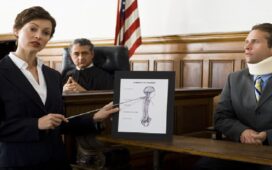Work-related back injuries continue to be a pressing issue in today’s workforce. These injuries, often caused by strenuous tasks, improper lifting techniques, or long hours spent at a desk, can significantly impact an individual’s quality of life. Understanding the common causes, preventive measures, and compensation avenues is crucial in effectively addressing this issue.
In the event of a work-related back injury, maximizing compensation becomes paramount. Adequate compensation ensures injured workers receive the support they need to recover and maintain their financial stability. It’s not just about financial gain; it’s about securing the future and ensuring that medical bills, lost wages, and rehabilitation costs are covered, allowing the injured individual to focus on their recovery and well-being. In this article, we will explore the avenues available for maximizing compensation after a work-related back injury and why it is essential to do so
Understanding Work-Related Back Injuries
Types of Work-Related Back Injuries
Work-related back injuries come in various forms, each with its own challenges. These injuries range from strains and sprains to more severe conditions like herniated discs and fractures. While strains and sprains often result from overexertion, heavy lifting, or awkward postures, more severe injuries may occur due to accidents or repetitive motions.
Common Causes and Risk Factors
A combination of factors typically causes work-related back injuries. Prolonged periods of sitting or standing, improper lifting techniques, and poor ergonomics play a significant role. Workplace environments requiring heavy lifting without proper training and equipment can also escalate the risk. It’s essential to be aware of these risk factors and take proactive measures to prevent work-related back injuries, such as proper training, ergonomic adjustments, and regular breaks to alleviate strain on the spine.
Navigating the Workers’ Compensation System
The Basics of Workers’ Compensation
Workers’ comp is a state-mandated program that provides medical and financial benefits to injured employees. It covers a range of injuries, including those to the back. To maximize your compensation, it’s crucial to promptly report your injury to your employer and seek medical attention. Keep a detailed record of your medical visits, treatments, and any work restrictions your healthcare provider provides. These records will play a pivotal role in your claim process.
Documenting Your Injury
Start by immediately reporting your injury to your supervisor, clearly explaining how it occurred. Seek medical evaluation without delay, ensuring that the healthcare provider accurately documents your injury, its cause, and its relation to your job duties. Keep copies of all medical reports, bills, and prescriptions. Also, log any missed workdays due to your back injury. This meticulous record-keeping will help streamline your workers’ compensation claim, ensuring you receive the support you need during your recovery without unnecessary hassles.
Seeking Medical Treatment
Choosing the Right Healthcare Provider
Selecting the right healthcare provider is crucial for work-related back injuries. Start with your primary care physician, who can offer initial guidance and referrals to specialists like orthopedic experts or physiatrists. Assess providers based on their experience and ability to work with your employer’s workers’ compensation program.
Rehabilitation and Physical Therapy
Rehabilitation and physical therapy are vital for recovery. Professionals will design tailored plans to improve mobility, reduce pain, and restore functionality. They also offer ergonomic advice to prevent future injuries. Staying committed to this regimen is essential for a smoother recovery and maximizing compensation benefits.
Surgery and Long-Term Care
In some cases, surgery may be necessary. Your medical team will assess the need for surgery and explore non-surgical options first. If surgery is recommended, work closely with your team to understand the procedure and expected outcomes. For severe injuries requiring long-term care, regular follow-up and adherence to treatment plans are crucial for a successful recovery and optimal compensation outcomes.
Maximizing Compensation
Understanding Compensation Types
When dealing with work-related back injuries, you must be aware of the various types of compensation you may be entitled to. These can include medical benefits covering your treatment expenses, wage replacement benefits to compensate for lost income during recovery, and even vocational rehabilitation if you cannot return to your previous job.
Negotiating Compensation
Once you understand the compensation types, effective negotiation becomes vital. Start by documenting your injury thoroughly, including medical records, bills, and evidence of negligence or unsafe working conditions. It’s advisable to consult with an experienced workers’ compensation attorney who can guide you through the negotiation process, ensuring you only settle for what you deserve.
Returning to Work Safely
Rehabilitation and Reintegration
After a work-related back injury, successful rehabilitation and reintegration into the workforce are paramount. Tailored physical therapy programs can aid in recovery, focusing on strengthening the injured area and improving overall mobility. Open communication with your employer about your progress is also essential, allowing for a smooth transition back to your pre-injury duties.
Workplace Accommodations
To ensure a seamless return to work, explore accommodations that alleviate strain on your injured back. These adjustments may include ergonomic furniture, modified workstations, or flexible scheduling to accommodate medical appointments or necessary rest breaks.
Preventing Future Injuries
To safeguard against future work-related back injuries, prioritize proactive measures. This involves maintaining proper posture, using ergonomic equipment, and incorporating regular exercises to strengthen your back and core muscles.
In summary, addressing work-related back injuries requires a multi-faceted approach. From understanding the causes to navigating the workers’ compensation system and maximizing compensation, this guide equips you with essential knowledge. You can secure your recovery and future well-being by prioritizing rehabilitation, negotiation, and workplace accommodations.
Publisher’s Details:
Cohen & Marzban Personal Injury Attorneys
714 W Olympic Blvd STE 631, Los Angeles, CA 90015
(866) 973-6882
losangelespersonalinjury.attorney
info@losangelespersonalinjury.attorney
If you’re seeking legal guidance beyond work-related injuries, Cohen & Marzban, the most dependable personal injury attorneys in Los Angeles, CA, can assist you. Check out their recent blog posts on “Guide to Claiming Damages for DUI Accidents in Los Angeles.
<iframe src=”https://www.google.com/maps/embed?pb=!1m18!1m12!1m3!1d3305.9777830483536!2d-118.26350489999999!3d34.044441!2m3!1f0!2f0!3f0!3m2!1i1024!2i768!4f13.1!3m3!1m2!1s0x80c2c78c854648d7%3A0x93be9e34b949882d!2sCohen%20%26%20Marzban%20Personal%20Injury%20Attorneys!5e0!3m2!1sen!2sph!4v1691504797976!5m2!1sen!2sph” width=”600″ height=”450″ style=”border:0;” allowfullscreen=”” loading=”lazy” referrerpolicy=”no-referrer-when-downgrade”></iframe>








